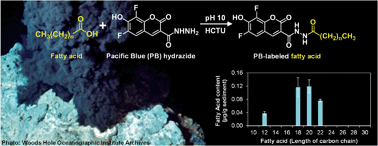Microchip nonaqueous capillary electrophoresis of saturated fatty acids using a new fluorescent dye†
Abstract
We demonstrate nonaqueous labeling and separation of the full range of short to long saturated fatty acids (C2 to C30) for the first time on a microfluidic device. A new fluorescent dye, Pacific Blue hydrazide, labels the carboxylic acid in a two-step, one-pot reaction to enable detection via laser-induced fluorescence at 405 nm excitation. Limits of detection for C10 to C30 acids range from 0.9 to 5.7 μM. Fatty acids were successfully quantified in a sediment sample from the ‘Snake Pit’ hydrothermal system of the Mid-Atlantic Ridge, demonstrating the potential of this method to help characterize microbial communities through targeted biomarker analysis. Such a technique could also be utilized to differentiate between abiotic and biotic compounds in the search for life beyond Earth.


 Please wait while we load your content...
Please wait while we load your content...